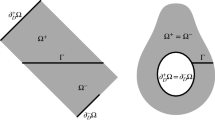Abstract
By the method of digital correlation of speckle images, we record the displacements in the vicinity of the crack tip in plane specimens of D16AT alloy. The field of elastoplastic displacements is determined in the vicinity of the crack tip under static loading. By using the distribution of displacements, we compute the levels of strains ε y on the continuation of the crack. The theoretical results are in good agreement with the experimental data in estimating the length of the plastic zone for the limiting equilibrium state.
Similar content being viewed by others
REFERENCES
V. V. Panasyuk, A. E. Andreikiv, and S. E. Kovchik, Methods for the Evaluation of the Crack Resistance of Structural Materials [in Russian], Naukova Dumka, Kiev (1977).
GOST 25.506-85. Strength Analysis and Tests. Methods for Mechanical Testing of Metals. Determination of the Characteristics of Crack Resistance (Fracture Toughness) under Static Loading [in Russian], Izd. Standartov, Moscow (1985).
V. V. Panasyuk, Limiting Equilibrium of Brittle Cracked Bodies [in Russian], Naukova Dumka, Kiev (1968).
BSI-DD19: Methods for Crack Opening Displacement (COD) Testing, British Standard Institution (1978).
I. Ingham, G. R. Egan, D. E. Iliott, and T. C. Harisson, The Effect of Geometry on the Interpretation of COD Test Data, Practical Application of Fracture Mechanics to Pressure Vessel Technology (1971).
D. J. Chen, F. P. Chiang, Y. S. Tan, and H. S. Don, “Digital speckle-displacement measurement using a complex spectrum method,” Appl. Opt., 32(11), 1839–1849 (1993).
L. I. Muravs’kyi, O. P. Maksymenko, and O. M. Sakharuk, “Evaluation of transverse shifts of the surface of a material by the methods of speckle correlation,” Vidb. Obrob. Inform., Issue 18, 95–99 (2003).
O. P. Maksymenko, L. I. Muravs’kyi, and M. O. Lytvyn, “The choice of the parameter of inverse filter for the digital method of measuring of the displacements of speckles,” in: Physical Methods and Tools for Monitoring Media, Materials, and Products [in Ukrainian], Issue 8, Lviv (2003), pp. 151–156.
B. V. K. Vijaya Kumar and L. Haseebrook, “Performance measures for correlation filters,” Appl. Opt., 29, No.20, 2997–3006 (1990).
A. E. Andreikiv, Three-Dimensional Problems of the Theory of Cracks [in Russian], Naukova Dumka, Kiev (1982).
A. Yu. Zhilyukas, Fracture of Structural Elements [in Russian], Mokslas, Vilnius (1988).
V. V. Panasyuk, Mechanics of Quasibrittle Fracture of Materials [in Russian], Naukova Dumka, Kiev (1991).
GOST 1497-84. Metals. Methods for Tensile Testing [in Russian], Goskomstandart SSSR, Moscow (1985).
Author information
Authors and Affiliations
Additional information
__________
Translated from Fizyko-Khimichna Mekhanika Materialiv, Vol. 40, No. 5, pp. 67–72, September–October, 2004.
Rights and permissions
About this article
Cite this article
Panasyuk, V.V., Ivanyts’kyi, Y.L. & Maksymenko, O.P. Analysis of the Elastoplastic Deformation of the Material in the Process Zone. Mater Sci 40, 648–655 (2004). https://doi.org/10.1007/s11003-005-0095-9
Received:
Published:
Issue Date:
DOI: https://doi.org/10.1007/s11003-005-0095-9




